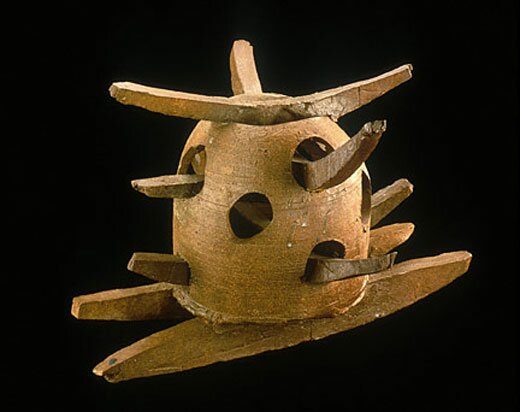“I claim this as a pot”
Posted by ben on 27 Feb 2008 at 02:01 am | Tagged as: books, ceramics, essays, responses/reviews

This is the first half (or so) of Garth Clark’s Subversive Majesty: Peter Voulkos’ Rocking Pot (included in , his brilliant book on ceramic art):
Rocking Pot is inarguably one of Peter Voulkos’ most inventive and important works. Its strength comes from its intense mixture of ambiguity and ambivalence. Its form is perplexing because it seems familiar; a relative of the domestic pot. Yet its self-penetration of volume and its strange base, made up of two curved feet or “rockers,” sows confusion and challenges its claim to vesselness. It presents itself simultaneously as a pot, a sculpture, and a demented birdfeeder. But Voulkos has no such confusion about the piece. Unequivocally he has stated, “I claim this as a pot.”
That, then, should be the last word on the subject. But in the world of ceramics there is a curious tendency to “upgrade” pots to sculpture when they project the energy of art, as though the pot is too lowly a medium for higher levels of expression. Obviously this is often at the hands of critics who have not spent any time with a Ming vase or a Mimbres bowl. But this elevation to sculpture is meant to be a compliment to the artist (albeit backhanded), and undoubtedly this is what Rose Slivka intended when she described Rocking Pot as “one of Voulkos’s earliest outright sculptures. The pottery technique is evident, while the pottery function is subverted to the formal invention.”
This statement perhaps best reveals the core misunderstanding among the fine arts in the (under) appreciation of the dynamism of pottery. Pots do not cease to be pots when function is subverted. Indeed, for millennia, denying function has been one of humankind’s ways of setting aside certain vessels for a different role, one that perforce became ritualistic and contemplative. Sometimes the act of removing function was profound, as in the Mimbres culture’s practice of putting a hole into the bottom of bowls of the deceased, to allow their souls to escape into the spirit world. This precluded domestic/utilitarian ideas of containment in favor metaphorical containment, in this case a purposeful permeability. In other cases function was obscured rather than denied for reasons of whimsy — to tease the user, as with the so-called puzzle jugs and mugs of the Medieval period.
What supports Voulkos’ insistence that this object be seen as a pot is that it becomes more intriguing when viewed in ceramic terms rather than from a purely sculptural viewpoint. The act of cutting holes into an abstract sculpture is primarily a formal act. Cutting holes into a pot is a violation. It upsets orderly notions of utility and culture. In pottery, volume is a sacred space. Holes deliberately placed by the potter provide entrances and exits. But when punctured in the seemingly destructive and random manner of the Rocking Pot, the vessel can no longer serve its literal purpose of containment. By further skewering the interior of his pot with his curved rockers, Voulkos adds an edge of surreal spatial violence.
Violence against the vessel, however, was not Voulkos’ goal. If the sanctity of the pot has been bruised, it is simply because it has come up against the intense energy and physicality with which the artist imbues his vessels. The holes serve many purposes in this piece. On one level they are drawings in three dimensions (much like Lucio Fontana’s paintings and sculptures from his Concetto Spaziale series). One may even view them more conservatively as pottery decorations in their most abstract form. But they are also spy-holes into the interior architecture of the vessel. They reveal the pot’s powerful inner structure, which those who admire pottery as an art already know exists, but few have seen exposed in so visceral a manner.
Sock-a-bye Baby
Great read…great inspiration, really. Thanks
Yellow Book